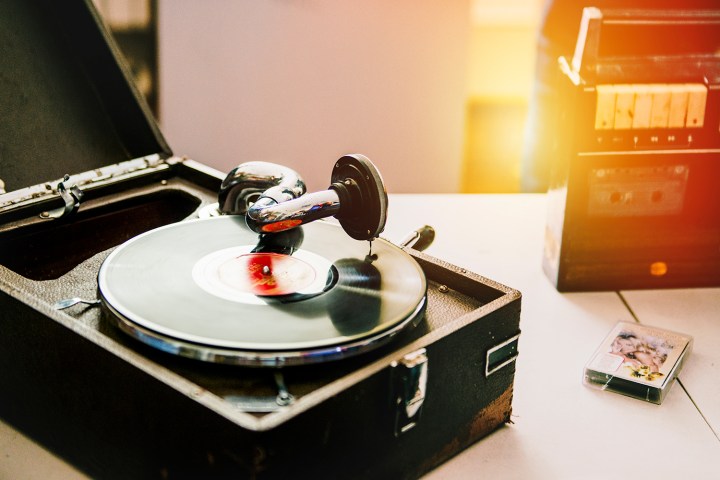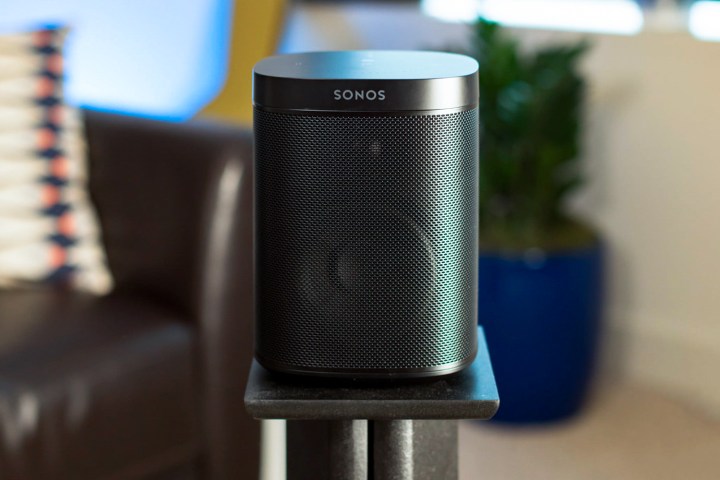
Whether you grew up listening to MP3 files on an iPod or spinning 78 RPM vinyl records on an all-in-one jukebox, the way you’ve listened to your favorite music has almost certainly changed in your lifetime. Our history of home audio systems will take you from the beginning of listening to music around a console radio at home all the way to the streaming audio present, providing context for each change in format and listening style — and hopefully taking you on a fun trip down memory lane.

Console Radio
1920s to present
Before TV and the internet, folks gathered around radios to get their news and entertainment. Following technological developments in sound amplification and transmission that occurred during World War I, the first commercial broadcasts began in the 1920s, with radio quickly becoming the first major mass media outlet in the world, and revolutionizing the way that humans were able to consume new information. Big wooden radios were the centerpiece of each family’s living room, and groups used to huddle around the massive armoires of sound to listen to live news, sports, and music on the AM and FM airwaves. Just like what would become the internet of the future, not all could tell news from fiction; When a radio version of H.G. Wells’ The War of the Worlds was first broadcast in October 1938, numerous listeners actually believed they were hearing reports of a real alien invasion.

Record Player
1920s-Present
Though the original turntables were created in the late-1800s, the modern turntable as we know it didn’t really see production until the mid-1920s, when 78 RPM discs became standardized in the United States. Bigger and shorter playing than the 33 RPM long-playing discs that would eventually replace them, these first records preserved the sounds of big band jazz, classical, and pop music of the day, often with just one or two songs per side. Typically hand wound, many of the original turntables played music out of a large horn, rather than electrically-powered speakers. Who knew this format would see such a resurgence in popularity nearly a century later?

One piece Hi-Fi System
1950s-1960s
With the growth of suburbia that followed World War II, the living room gained an updated (and even classier looking) version of the original console radio system and horn-based turntable. Gorgeously built wooden consoles contained amplifier-powered stereo speakers, with a turntable and radio hidden under a lid in the center. Fancier iterations of these systems even hid full bars and TV sets, allowing dapper gentlemen and gentlewomen to grab a drink and recline while listening to their favorite record, radio station, or watching the evening news. You know Don Draper had to have one.

Component stereo
1970s-Present
As technology continued to develop and several different formats began to exist in home audio, younger listeners moved away from the classy all-in-one setups of their parents, instead buying large multi-piece sets that consisted of an amplifier, speakers, radio, turntable, and tape (and later CD) players. Though audio enthusiasts had begun purchasing each component and assembling high-end systems out of the gear since the first high end home audio gear became available in the 1950s, the time when component stereo systems leaped into every home was the 1970s and 1980s, when great-looking — and often mediocre-sounding — pre-packaged systems were the norm.

Reel to Reel Player
1950s-1980s
Though the vast majority of music was recorded on tape from the 1950s until the 1980s, the first tape machine that was practical for home use was the reel to reel player. Popular among serious audio enthusiasts, reel to reel offered impeccable fidelity, providing better analog audio playback than one could ever achieve from vinyl records. The players remain prized among audio enthusiasts to this day, but can be difficult to maintain, and content remains tough to find (and expensive when you do). Ever heard of quadrophonic sound? The reel to reel was at the center of the failed format.

8-Track Tape Player
1960s-1980s
The first commercially viable portable tape player, the eight track was perhaps most noted for its inclusion in many classic-era muscle cars, with Ford adopting the player in the 1966 models of its Mustang and Thunderbird, as well as its high-end Lincoln brand. Because of the 8-track’s portability and success in cars, many people also bought home players for their 8-track cassettes, allowing them to listen to the same tapes both at home and on the go. Though car-mounted record players did exist before the 8-track took hold, they were very costly and prone to skipping, and this meant the 8-track was the first format to really change the way most people listened to music in cars.

Compact Cassette Player
1970s-Present
Compact cassettes were originally introduced around the same time as larger 8-track cassettes, but it took a few improvements in technology before the fidelity became optimal for listening to music. That said, because of their smaller size and improved sound, high-fidelity cassettes were in massive demand by the 1970s and 1980s, with home players and the innovative, hyper-portable Sony Walkman taking the audio world by storm. By the early 1980s, virtually every component stereo system would include a tape player, and everyone used portable tape players and car cassette decks to take their favorite music outside the house with them. The medium also made it possible to record music from other sources. Anyone want a mixtape?

CD Player
1980s-Present
The digital audio revolution began with the introduction of the Compact Disc, which first saw commercial production in 1982 — though it would take a few years for CDs to appear in the homes and cars of average consumers. Originally developed as a successor to the vinyl record format, the CD achieved its goal and more, eventually becoming a standard for not only home and car audio, , but also for computer data storage. Thanks to Sony’s Discman, the CD also saw digital music go portable at a large scale for the first time.

Digital Audio Tape (DAT) Player
1980s-1990s
Intended as the digital successor to cassette much in the same way CD was supposed to replace vinyl, Digital Audio Tape hit the scene in the mid-1980s and 1990s, providing a tape-based digital medium to listen to and record music. The format experienced moderate success in certain nations like Japan, and as a computer storage medium, but never saw broad popularity, largely because of the success of CDs.

MiniDisc Player
1990s-2000s
Another would-be replacement for the compact cassette was Sony’s MiniDisc, which was originally developed in the early 1980s, but didn’t see production until the early 1990s. Cheaper that the DAT format the company was also pushing, the MiniDisc was designed to appeal to audio enthusiasts who wanted a small form factor and cassette-like recordability. The introduction of writeable CD technology limited the success of the MiniDisc player, especially as prices for once-costly blank CD-R discs diminished considerably by the late-1990s.

All-In-One Player (Boombox)
1980s-Present
Those who wanted a smaller listening system for corners of rooms or to take with them on trips got what they were looking for in the 1980s, when battery powered, two-speaker boomboxes first hit the market. Made with built-in cassette players and radio (and later CD players), boomboxes also often included A/C plugs for when not on the road, and some even included 3.5 mm AUX Ports. If you were into breakdancing in the 1980s, you definitely had a boombox to go with your cardboard dancepad. Eventually, companies like Bose realized that higher-end consumers wanted a smaller home stereo option too, but didn’t necessarily care about portability, so they company released the still-popular Bose Wave system.

MP3 Player
1990s-Present
Originally standardized in the early 1990s, the MPEG III audio codec allowed digital audio to be compressed from CD quality to allow for improved storage capacity on the smaller hard drives of the day. With the rise of home computing and the internet, this way of storing and playing audio files became increasingly popular, and fueled the creation of portable players for consumers. Though once-iconic players like the Archos Jukebox and Rio Karma were among the best during the rise of the market that Napster helped fuel, Apple’s iPod quickly became the standard piece of hardware in the category, and numerous manufcaturers built all-in-one-style systems with iPod docks, as well as stereo receivers with 3.5 mm AUX inputs for MP3 playback.

Streaming Music Stereo
2000s-Present
As smartphones came into the fold and streaming services like Spotify and YouTube began to overtake Apple’s iTunes and similar MP3-focused marketplaces as the primary means with which consumers listened to home audio, companies like Sonos began making internet-connected speakers that allowed listeners to connect to their favorite content. Denon HEOs and others also offer similar streaming music systems, which replace the central stereo that was once found in listener’s homes in favor of many single speaker systems spread throughout one’s house — and controllable via computer and smart phone apps.

Smart Speaker
Present
With the invention of Amazon Alexa, Google Home, and Apple’s Homepod, smart speakers have become a new standard by which listeners can jam out to their favorite tunes at home. Increasingly featuring larger and better-sounding speakers, these systems often integrate with external speakers via Bluetooth or 3.5 mm jack, and allow viewers to control playback with their smartphone or voice.



